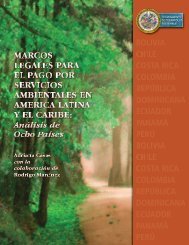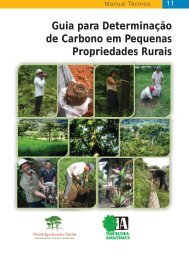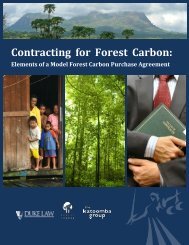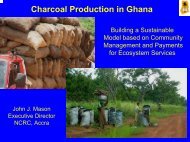Guide on Climate Change and Indigenous Peoples
Guide on Climate Change and Indigenous Peoples
Guide on Climate Change and Indigenous Peoples
- No tags were found...
You also want an ePaper? Increase the reach of your titles
YUMPU automatically turns print PDFs into web optimized ePapers that Google loves.
• What is the sec<strong>on</strong>d approach?The sec<strong>on</strong>d approach to reducing the level of GHGs is to attemptto increase the earth’s ability to absorb carb<strong>on</strong> dioxide throughreforestati<strong>on</strong> or other more experimental methods such as carb<strong>on</strong>capture <strong>and</strong> storage (CCS).Alternative Forms of Energy <strong>and</strong> Implicati<strong>on</strong>s<strong>on</strong> <strong>Indigenous</strong> <strong>Peoples</strong>• No to nukes! - Nuclear power poses special problems for many indigenouspeoples, because nuclear waste is often stored in places far from largeurban centers <strong>and</strong> areas inhabited by them. Rather than having to tolerateunauthorized intrusi<strong>on</strong>s up<strong>on</strong> their l<strong>and</strong>s, indigenous peoples should have theright to give or withhold prior <strong>and</strong> informed c<strong>on</strong>sent, <strong>and</strong> they should possessa veto power c<strong>on</strong>cerning nuclear waste storage projects <strong>on</strong> their territories <strong>and</strong>l<strong>and</strong>s.• Wind <strong>and</strong> solar energy - Wind energy projects could bring clean energyto the world <strong>and</strong> a tremendous windfall of ec<strong>on</strong>omic development to someindigenous communities. It is estimated that the wind energy potentialworldwide is 15 times the world’s energy dem<strong>and</strong>s, with much of this energypotential located <strong>on</strong> their l<strong>and</strong>s. Using solar power to generate electricity wouldseem to be a perfect cultural-ec<strong>on</strong>omic match for indigenous people seeking toparticipate in climate mitigati<strong>on</strong>.• Biofuels - The growing use of biofuels is more c<strong>on</strong>troversial. Of particularc<strong>on</strong>cern is the dramatic shift in agricultural producti<strong>on</strong> patterns to meet thedem<strong>and</strong> for biomass <strong>and</strong> the fact that the nitrogen fertilizers used to increasebiomass release such potent nitrous oxides that the net effect <strong>on</strong> GHGemissi<strong>on</strong>s is actually worse than if plain diesel were used instead of biofuel.• Large hydroelectric dams - <strong>Indigenous</strong> peoples are also c<strong>on</strong>cerned about themassive increase in the building of large hydroelectric dams, because of thepotential displacement of indigenous peoples from their ancestral territories.8What are the indigenouspeoples’ perspectives <strong>on</strong> climatechange mitigati<strong>on</strong>?• The best way to mitigate climate change is to change the unsustainableproducti<strong>on</strong> <strong>and</strong> c<strong>on</strong>sumpti<strong>on</strong> patterns which is still the prevalent systemdominating this world. The best mitigati<strong>on</strong> measures involve changinglifestyles, individually <strong>and</strong> collectively, <strong>and</strong> structurally changing thedevelopment path towards a sustainable <strong>and</strong> low-carb<strong>on</strong> <strong>on</strong>e.• The market-based mechanisms are very limited. These just reinforcefurther the inequities which have been created by the unregulatedmarket or the so-called free market instead of addressing the root causesPART III: <strong>Climate</strong> <strong>Change</strong> Mitigati<strong>on</strong> Measures: Impacts <strong>on</strong> <strong>Indigenous</strong> <strong>Peoples</strong> 35
















